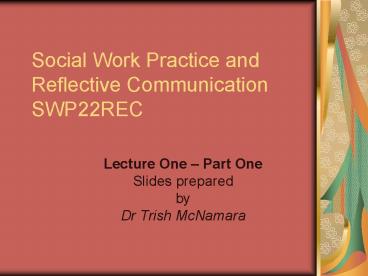Social Work Practice and Reflective Communication SWP22REC - PowerPoint PPT Presentation
1 / 30
Title:
Social Work Practice and Reflective Communication SWP22REC
Description:
Communication theories in general ... Communication theories influencing social work approaches and practice skills. Social work values and ethics and communication ... – PowerPoint PPT presentation
Number of Views:1102
Avg rating:3.0/5.0
Title: Social Work Practice and Reflective Communication SWP22REC
1
Social Work Practice and Reflective
CommunicationSWP22REC
- Lecture One Part One
- Slides prepared
- by
- Dr Trish McNamara
2
Overview of course outline
- Aims
- Teaching modalities
- Lectures
- Seminars
- Text Book
- Readings
- AV resources
- Evaluation group exercise, essay
3
This course aims to reflect upon
- Communication theories in general
- Communication in a context of social diversity
age, gender, culture, ethnicity,
ability/disability, geography and so on - Communication theories influencing social work
approaches and practice skills - Social work values and ethics and communication
- Students own communication style, values and
beliefs - Students beginning attempts at learning
professional communication skills at micro, meso
and macro levels
4
Bi-partite template underpinning REC
- Developmental continuum (DLC)
- Ecological systems levels (ITP,HSO)
5
Teaching modalities
- One two hour lecture
- Make contact in writing re special needs for
Seminar times NOW!!! - Emphasis on interaction and participatory adult
learning in both lectures and seminars - Discussions, role plays, experiments, quizzes,
group activities, journal writing - Guest lecturers
6
Expectations
- Respect
- Genuineness
- Honesty and integrity
- Confidentiality
- Support
- Equity and access
- Humour
- Creativity
7
Readings
- Adler R and Rodman G (2006) Understanding human
communication New York ,NY Oxford University
Press prescribed text - Student Success Manual is incorporated
- All other texts listed are on Reserve
8
AV materials
- All general AV materials listed are on Reserve
- Some popular release movies are on Reserve
9
Assessment
- Group exercise and Written Reflection 50
- Reflection due two weeks after the class exercise
- Essay 50
- due Monday, November 12th, 2005
10
Human communication What is it?
- 1,200 word definition of communication - Oxford
English Dictionary - communication refers to the process of human
beings responding to the symbolic behaviours of
other persons - Adler and Rodman (2006) p.4.
11
A definition of communication- from the Adler
and Rodman (2006) glossary p.502
- A continuous, irreversible, transactive
process involving communicators who occupy
different but overlapping environments and are
simultaneously senders and receivers of messages,
any of which are distorted by physical and
psychological noise.
12
Communication is human
13
Communication is a process
- Communication is a transactional process
- Communication is intentional and unintentional
- Communication involves simultaneous sending and
receiving of messages - Communication is fluid not static
- Communication is relational, not individual
- Communication is more like a motion picture than
a photo album - Adler and Rodman(2006) pp 14-17
14
- No man is an island, entire of itself...any
man's death diminishes me, because I am involved
in mankind and therefore never send to know for
whom the bell tolls it tolls for thee." - John Dunne (1624)
- Meditation XVII
15
Functions of communication
- Physical needs
- Identity needs
- Social needs
- Practical needs
16
Communication is symbolic
- We overcome the arbitrary nature of symbols by
linguistic rules and customs - Example libro buch book
17
Meanings of communication
- How does being interested in communication
differ from being interested in life? - Brent Rubin (1988)
- cited in Adler and Rodman (2006)
18
Some of the many meanings of communication.
- Interdisciplinary heritage philosophers
(Foucault), anthropology (Mead), zoology (Fossey)
, sociology (Bateson), psychology (Sullivan)
psychiatry (Freud), social work - Field (childrens TV) and activity
- Humanity and social science
- Natural (informal) and professional communication
(motivational speakers, pastors, PR, social
workers) - Communication (face to face) and communications
(mass media and internet)
19
Types of communication
- Intra-personal
- Dyadic/interpersonal
- Small group
- Public
- Mass
20
Reflective communication
- How do we reflect upon communication?
- Why is reflection important?
21
The Reflective Practitioner
- The reflective practitioner how professionals
think in action - SchÖn, Donald (1983) First edition New York
Basic Books
22
- Among younger professionals and students
there are many who find the professions without
real interest in the values they are supposed to
promote. - SchÖn (1983) p.12
23
- ..social workers have multiple shifting
images of the nature of their practice.. - SchÖn,(1983) p.17
24
Contemporary social work focus on reflective
practice
- Fook, Jan (2004) A Method for Investigating
Practitioner Use of Theory in PracticeQualitative
Social Work.(3) 161-177.
25
- Each view of professional practice represents
a way of functioning in situations of
indeterminacy and value conflict - SchÖn p.17
26
Reflection in actionReflection on
actionAction may be words, behaviour or both
27
- Reflection on what we are saying and doing
leads us to seriously consider meaning
attribution.
28
Clarifying misinterpretations re communication
- Communication does not always require complete
understanding - Communication is not always a good thing
- No single person or event causes the others
reaction - Communication will not solve all problems
- Meanings rest in people, not words
- Communication is not simple
- More communication is not always better
- Adler and Rodman (2006) pp. 22-26
29
Ethics of communication
- Honesty commitment, obligation, congruence
- Integrity authority, power and
confidentiality,self determination - Inclusivity of difference (gender, race,
ethnicity, culture, values, beliefs) - OConnor, Wilson and Setterlund (1998) p.72
30
Self awareness and communication
- Our gender
- Our age
- Our marital and/or parental status
- Our occupation
- Our body image
- Being, knowing and becoming
- (Goldstein,1973)
- See also OConnor et al (1998) p.52-3































